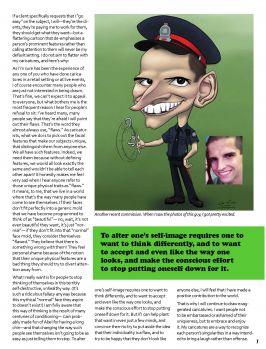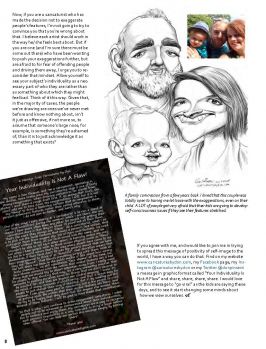Why I Exaggerate
 | |
| Author | Don Pinsent |
|---|---|
| Genre | |
| Published | EF Issue 2018.2 |
Publication date | Spring 2018 |
| Media type |
|
| Pages | 6-8 |
| Website |
|
Article Transcript
Over the years, there have been countless debates among caricaturists as to whether it is acceptable for people of our profession to indulge in extreme exaggerations when drawing clients, or whether such distortions of a person’s features are to be considered potentially offensive and therefore should be avoided. The argument is probably only slightly younger than the act of caricaturing for money. I’m not going to say here that there is a solid right or wrong in this debate, or claim that every caricaturist should be striving for any prescribed level of extremism in his/ her artwork. I will only say that my personal style has long been one of fairly strong exaggerations (Okay, I’m no Manny Avetisyan or Sebastian Martin, but I try to push it).
If a client specifically requests that I “go easy” on the subject, I will—they’re the clients, they’re paying me to work for them, they should get what they want—but a flattering cartoon that de-emphasizes a person’s prominent features rather than calling attention to them will never be my default setting. I do not aim to flatter with my caricatures, and here’s why:
As I’m sure has been the experience of any one of you who have done caricatures in a retail setting or at live events, I of course encounter many people who are just not interested in being drawn. That’s fine, we can’t expect it to appeal to everyone, but what bothers me is the most frequent reason I hear for people’s refusal to sit: I’ve heard many, many people say that they’re afraid I will point out their flaws. That’s the word they almost always use, “flaws.” As caricaturists, what we do is to pick out the facial features that make our subjects unique, that distinguish them from anyone else. We all have such features. Indeed, we need them because without defining features, we would all look exactly the same and wouldn’t be able to tell each other apart! It honestly makes me feel very sad when I hear anyone refer to those unique physical traits as “flaws.” It means, to me, that we live in a world where that’s the way many people have come to see themselves. If their faces don’t fit perfectly into a generic mold that we have become programmed to think of as “beautiful”— no, wait, it’s not even beautiful they want, it’s just “normal”— if they don’t fit into that “normal” face mold, they consider themselves “flawed.” They believe that there is something wrong with them! They feel personal shame because of the notion that their unique physical features are a bad thing they should try to divert attention away from.
What I really want is for people to stop thinking of themselves in this terribly self-destructive, unhealthy way. (It’s such a ridiculous fallacy anyway because this mythical “normal” face they aspire to doesn’t exist!) I am fully aware that this way of thinking is the result of many centuries of conditioning— Cain probably made fun of Abel for having a long chin—and that changing the way such people see themselves isn’t going to be as easy as just telling them to stop. To alter one’s self-image requires one to want to think differently, and to want to accept and even like the way one looks, and make the conscious effort to stop putting oneself down for it. But if I can help plant that want in even just a few minds, and convince them to try to put aside the idea that their individuality is a flaw, and to try to be happy that they don’t look like anyone else, I will feel that I have made a positive contribution to the world.
That is why I will continue to draw exaggerated caricatures. I want people not to be embarrassed or ashamed of their uniqueness, but to embrace and enjoy it. My caricatures are a way to recognize each person’s singularities in a way intended to bring a laugh rather than offense.
Now, if you are a caricaturist who has made the decision not to exaggerate people’s features, I’m not going to try to convince you that you’re wrong about that. I believe each artist should work in the way he/ she feels best about. But if you are one (and I’m sure there must be some out there) who have been wanting to push your exaggerations further, but are afraid to for fear of offending people and driving them away, I urge you to reconsider that mindset. Allow yourself to see your subject’s individuality as a necessary part of who they are rather than as something about which they might feel bad. Think of it this way: Given that, in the majority of cases, the people we’re drawing are ones we’ve never met before and know nothing about, isn’t it just as offensive, if not more so, to assume that someone’s large nose, for example, is something they’re ashamed of, than it is to just acknowledge it as something that exists?
If you agree with me, and would like to join me in trying to spread this message of positivity of self-image to the world, I have a way you can do that. Find on my website caricaturesbydon.com, my Facebook page, my Instagram @caricaturesbydon or my Twitter @donpinsent a message in graphic format called “Your Individuality Is Not A Flaw” and share, share, share, share. I would love for this message to “go viral” as the kids are saying these days, and to see it start changing some minds about how we view ourselves.
See Also
External Links
This Navigation box may not show up on mobile browsers. Please see Exaggerated Features Issue 2018.2 for the full contents of this issue if the navigation box does not display.


